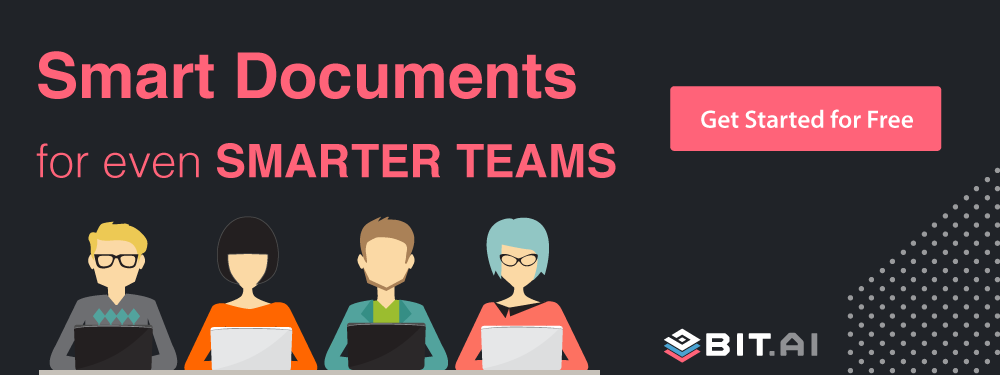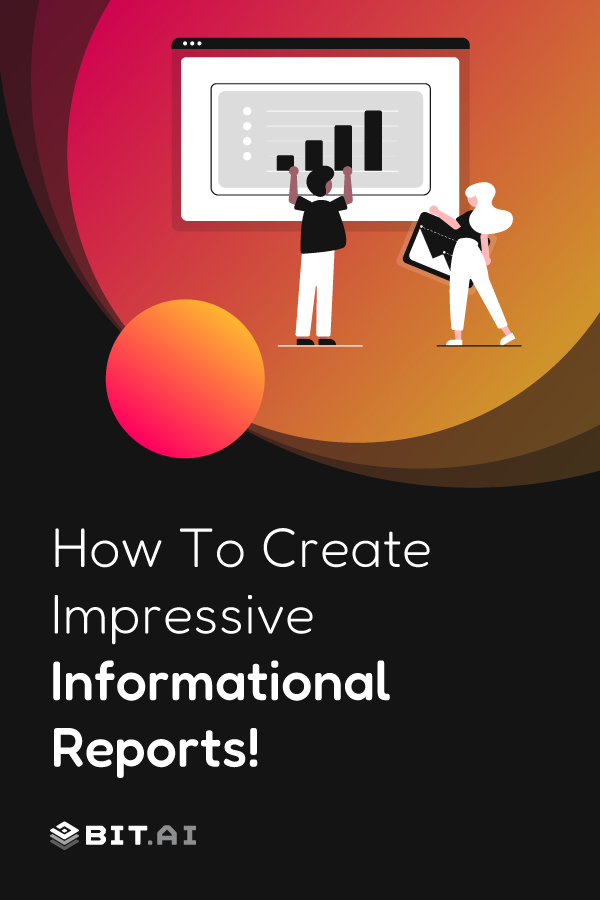Information is here. Information is there. Information is everywhere.
In a world that is crammed with information, how do you focus on the important ones? How do you separate the facts from the fiction? How do you ensure that what you get is free from any personal bias or views?
Whether you are in business or in academics or in any other field, and if you want to stay informed or make informed decisions, you need hard facts and objective informative details.
For that, you need informational reports.
But, what are they? How important are they? Can you write one by yourself?
So many questions and we have all the answers right here in this blog. So without further ado, let’s get down to the basics of informational reports!
What is an Informational Report? (Definition)
An informational report is a factual document which provides information in an organized and objective way, without analysis or recommendations.
Basically, it’s all about reporting facts. So, it often includes data, details, feedback, or any other type of information about any topic or event.
One major element of informational reports is that they don’t contain any arguments. They are always objective and maintain a neutral position that is free from personal views or of bias.
The purpose of these reports is to present detailed facts and inform the readers so that they can make a decision. Hence, the information inside an informational report is specific, complete, and relevant.
An informational report is usually read by officers, board of directors, and stockholders of a company, but depending on the contents of the report, it can be available or anyone in the company.
Some examples of informational reporting include decision-making reports, policy reports, compliance reports, status reports, etc.
Seems pretty basic, right? So, why are they important in a business? Let’s find out!
Top Benefits of Writing an Informational Report
1. Act as Medium Of Communication
In big companies, there is often a huge workflow that deals with multiple branches, departments, and teams. Any form of verbal communication often gets lost in that chain or network of people, which is why written reports are a crucial medium of communication for all.

Their main purpose is to communicate information to people and that is exactly what informational reports do because they aim to provide facts and details to all their readers. These are passed on from one person to another; thus, everyone is equipped with first-hand data.
2. Gathers and Organizes Data
An information report helps gather information about your company’s growth history, project details, and many other important areas. All of this information will be stored in a single place concisely and understandably for the people to access. It ensures that all data will be organized and designed in a standard format.
Must Read: Stop Risking Your Data — Build a Bulletproof Information Security Plan Now
3. Provides Accurate and Objective Information
Nobody writes their personal opinion or views in an informational report because they are purely based on facts and accurate information or data which are taken at face value.
They are always neutral in their approach, which is why they do not contain any arguments and remain free from bias. Thus, these information reports always provide an accurate and objective picture of the subject or topic.
4. Facilitates Decision-Making
Since information reports provide a full factual picture of the subject or topics they present, it makes it easy for businesses to keep track of their revenues, expenses, operations, and other activities. All these data help management make decisions for the company.
There is communication, the flow of information, and interaction, all of which facilitate or pave way for decision-making within a company.
Now that you know the importance of informational reports, let’s take a look at the steps involved in making one!
Key Elements of an Informational Report You Must Include
Most reports follow a very simple and basic structure during the writing process. Informational reports are no exception to that.
But, before we look at the writing process of an informational report, let’s consider some basic things to keep in mind to ensure that your report is in good order.
1. Brainstorming for Topics
The first thing that you must do before writing any informational report is to brainstorm topics. The goal is to inform the audience about a specific subject, so you have to pick the right topic for it. Make sure that you settle on a topic that will allow you to do proper research and present facts objectively.

Avoid choosing broad topics as that may result in a very long informational report. Try to narrow down even within broad topics so that it is a well-focused report which will help maintain focus.
2. Research on Topic
Researching is the next logical step after choosing a topic for your informational report. The main purpose here is to ensure that your report is purely based on facts and credible sources rather than on personal arguments.
Avoid anything that appears unclear and focus on reporting only accurate information. Make sure that you cross-reference your facts and data to maintain consistency in your reports.
3. Keep a Target Audience in Mind
When writing an informational report or any report for that matter, always have a target audience in your mind.
You should be aware of who all would want to read your report and why they would want to read it in the first place. It is also based on this factor that you kick-start your informational report.
4. Write Informational Report
Once you have data and information gathered and have also completed your research, you are ready to start writing your informational report. For this, you must have an idea of how you are going to write your report. The usual format includes an introduction, main body, and a conclusion.
Now that we have discussed some elements to keep in mind before writing an informational report, let’s dive into the actual writing part!
How to Create an Informational Report (Step-by-Step Guide)
Do you need to share clear and concise information on a particular topic? Informational reports are a powerful tool for presenting factual data in a well-organized way. They are used in a variety of settings, from classrooms to workplaces, to convey knowledge on almost any subject.
This guide will walk you through the key steps involved in crafting an effective informational report. By following these steps, you’ll learn how to structure your report, conduct thorough research, and present your findings in a way that is informative and engaging for your audience.
Step 1: Start With Introduction
Ever started reading a report and gotten bored right away? Let’s avoid that! The introduction is your chance to make a good first impression and get your reader excited to learn.
Here’s how to craft an introduction that grabs your reader’s attention:
- Hook ‘Em In! – Start with a bang! Use a question, a surprising fact, or a short anecdote related to your topic. For example, if your report is on honeybees, you could begin with: “Did you know a single bee can visit up to 100 flowers in one trip?” This piques the reader’s curiosity and makes them want to learn more.
- Introduce the Player: Your Topic! – Clearly state the subject of your report. This lets the reader know exactly what they’re about to dive into. Keep it simple and avoid overly complicated words.
- Give a Sneak Peek: What They’ll Learn! – Briefly mention the main points you’ll cover in the report. This gives the reader a roadmap and helps them understand what to expect.
- Thesis Statement: The Big Picture! – In one clear sentence, summarize the main idea of your report. This is like the central message you want your reader to remember.
Remember to keep it concise! Your introduction should be just a few paragraphs long.
Step 2: Include the Main Body
We’ve got the introduction out of the way, now it’s time for the main event: the body of your report. This is where you dive into the details and share all the interesting information you’ve gathered about your topic. Here are some tips to make your report’s body informative and easy to follow:
- Headings are Your Friends: Break down your main points into clear headings and subheadings. Imagine them as signposts, guiding your reader through the different sections of your report.
- Organize Your Information: Think about the logical flow of your information. Does it make sense to discuss the history first, then the different parts, and finally how it works?
- Use Examples and Facts: Don’t just tell, show! Use real-life examples, statistics, or interesting facts to illustrate your points and make the information come alive for your reader.
- Explain Technical Terms (if needed): If you’re using any technical terms your audience might not know, take a moment to explain them in simple language.
- Bullet Points and Tables: Bullet points and tables are great for presenting lists or data in a clear and concise way. They make it easier for your reader to understand complex information at a glance.
Here’s an Example:
Let’s say you’re writing a report on honeybees. In your body section, you could have headings like:
- The Importance of Honeybees (Explain their role in pollination)
- Life Cycle of a Honeybee (Break down the different stages with explanations)
- Threats Faced by Honeybees (List the challenges they face)
Under each heading, you would then use clear language, examples, and maybe even a simple diagram of a beehive to explain each point.
Step 3: Use Visual Elements
Visual elements like charts, graphs, pictures, and even maps can make your informational report way more interesting and easier to understand.
Here’s how to use visuals effectively:
- Pick the right picture: Don’t just throw in any random image. Choose visuals that directly relate to the information you’re explaining in that section of your report.
- Charts and graphs for numbers: Numbers can be hard to remember, especially in big chunks. Charts and graphs like bar graphs, pie charts, or line graphs can make those numbers come alive and show trends or comparisons easily.
- Tables for clear organization: If you have a lot of information with categories, like different types of something and their details, a table is a lifesaver. It keeps things neat and organized, making it easy for readers to find specific details.
- Pictures for real-life examples: Sometimes, a picture is worth a thousand words! If you’re explaining a process or an object, a clear picture can help readers understand exactly what you’re talking about.
- Maps for location, location, location: If your report is about a place or how something moves around, a map can be super helpful. It can show where things are happening or where something comes from.
Must Read: Unleash Your Team’s Genius: Create a Brainstorming Doc That Works!
Step 4: Write a Conclusion
The conclusion is like the closing statement of your report. It’s your chance to remind the reader of the key things you covered and leave them with a final thought. Here’s how to write a strong conclusion:
- Briefly Summarize Your Main Points: Don’t rewrite everything, but pick the 2-3 most important points you discussed in the body of your report. Briefly remind the reader what they learned.
Example: “This report explored the different types of dolphins, their habitat, and how they communicate.”
- Restate the Importance of Your Topic (Optional): Why is this information important? Remind the reader why this topic matters in a simple sentence or two.
Example: “Understanding dolphins helps us protect these fascinating creatures and their ocean homes.”
- Avoid Introducing New Information: The conclusion is for wrapping things up, not adding new details.
- End with a Final Thought (Optional): You can leave the reader with a thought-provoking question or a simple statement that ties back to your introduction.
Example: “Perhaps future research will help us unlock even more secrets about these intelligent animals.”
- Keep it Short and Sweet: A good conclusion should be just one paragraph long.
Step 5: Include Glossary and Bibliography
You’ve written a fantastic report packed with information, but there are two final steps to make it even better: a glossary and a bibliography. These might sound fancy, but they’re actually quite simple!
Glossary: Here’s how to build it
- Pick the Right Words: Go through your report and highlight any words that are technical, uncommon, or specific to your topic.
- Define Clearly: Write down each highlighted word in alphabetical order. Then, in a sentence or two, explain what the word means in simple terms.
- Example: Let’s say you wrote a report about robots. In your glossary, you might have “Bipedal (adjective): Walking on two legs, like a human.”
Bibliography:
- List Your Sources: Write down every book, website, article, or interview you used for your research.
- Follow a Format: There are different ways to format a bibliography, but a common one is MLA (Modern Language Association) style. You can find free MLA format guides online.
- Example: Here’s an example of an MLA formatted source for a website: Author’s Last Name, First Name. “Title of the Webpage.” Website Name, Date published, URL.
Step 6. Proofread Your Informational Report
Now that you have completed the entire writing process, the only thing left for you to do is to proofread and ensure that all your facts and data are accurate and free from personal bias. Look for spelling errors, grammatical mistakes, inconsistencies in punctuations, and check whether your sentences are properly structured.
Seems easier than you expected, right?
But wait! What if we told you we could make writing informational reports easier than it already is with just a few clicks?
Don’t believe us?
Then scroll down to see how!
Bit.ai: Ultimate Tool to Create All Types of Reports
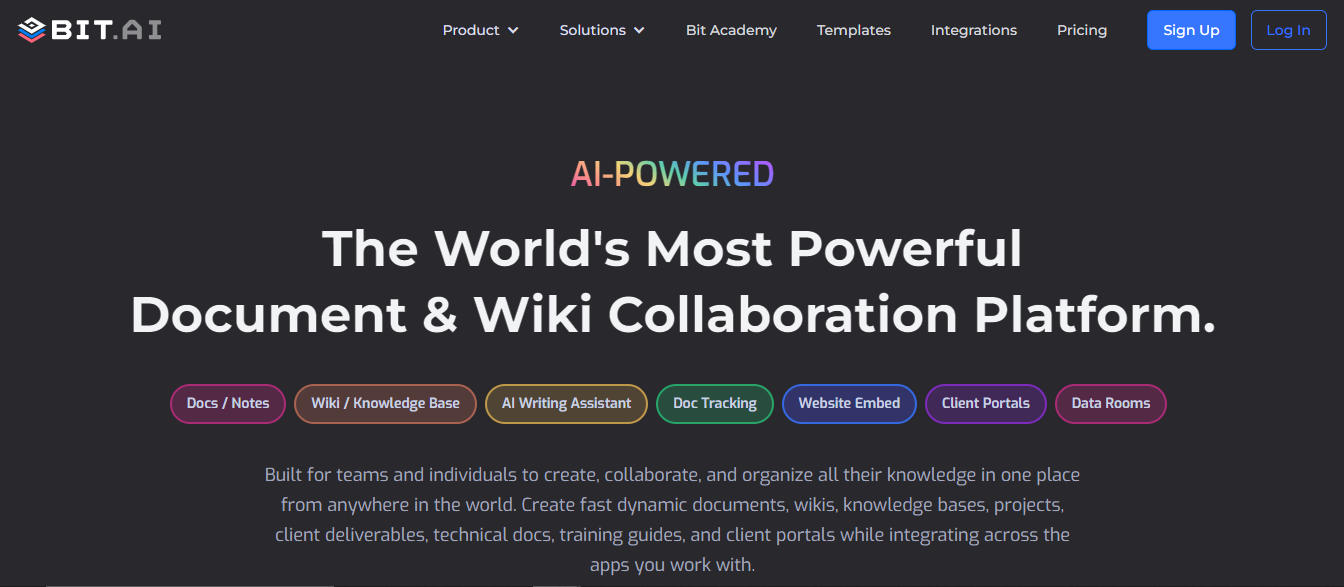
Gone are the days you spend hours on your computer trying to fix and align your reports and projects because technology has simplified our lives so much that all it takes is a few minutes and a few clicks for completing any task!
Yes, but how is this possible?
We present to you Bit.ai, a cloud-technology-based document collaboration platform that helps you create modern, digital integrated documents effortlessly.
… and it’s a boon for your informational reports! How?
Take a look at these features of bit.ai!
1. Document Templates
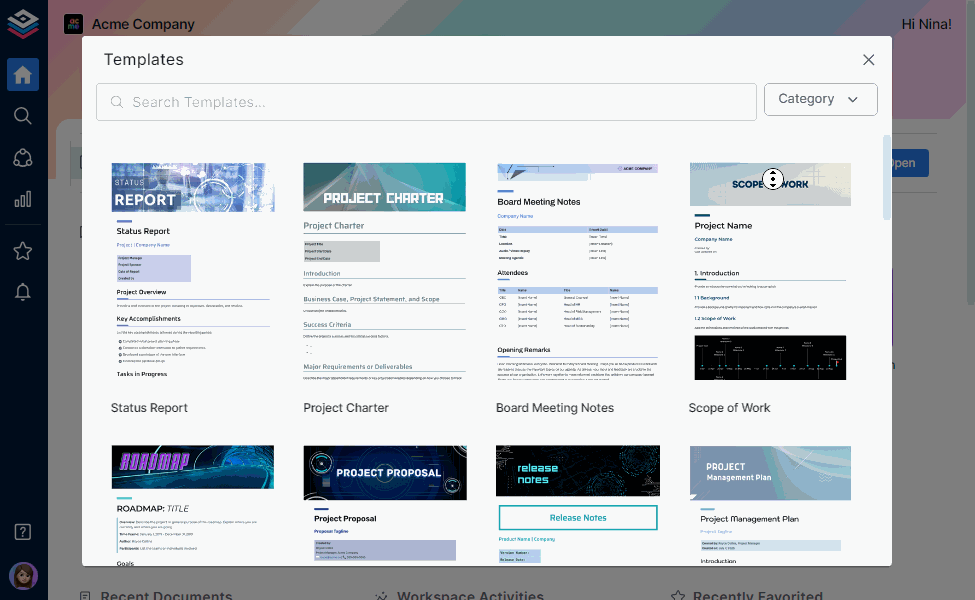
What if we tell you that the entire structure of your information report is already done and designed for you? That’s because Bit has an extensive template gallery that provides you with over 70+ ready-made templates from which you can choose your favorite! This basically means that you have a template for your informational report just waiting to be used. All you have to do is insert your text in a pre-formatted document and customize it wherever it is required! You no longer have to worry about how your document will look, just focus on your content!
2. Auto-Formatting
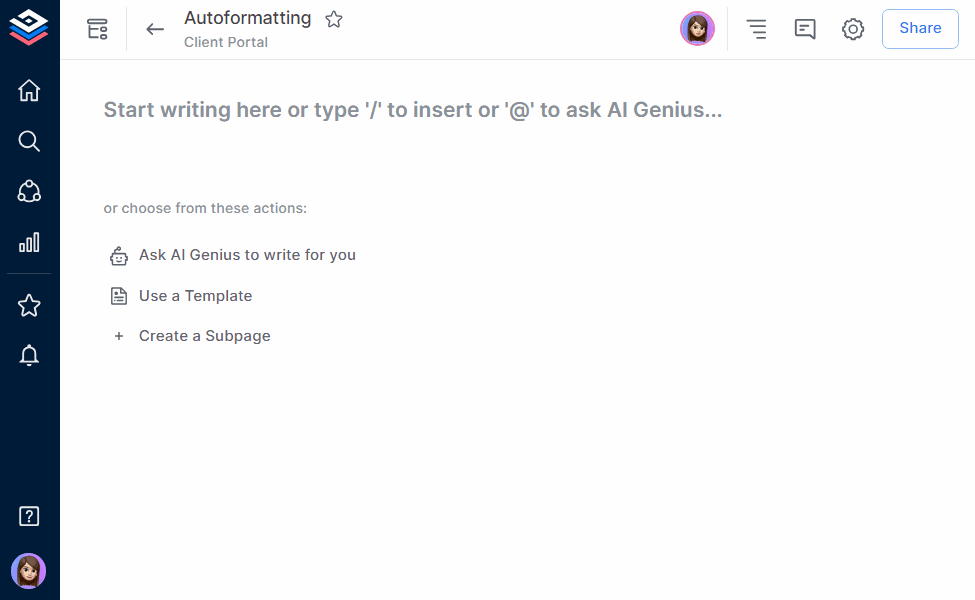
In addition to the amazing templates that Bit provides you, it automatically formats all your documents even if you don’t! You don’t have to bother about the margins, line spacing, numbering, and fonts of your document because Bit has a minimalistic design that ensures everything is uniform and neat. This saves you a lot of time and effort!
3. Supports 100+ File Formats
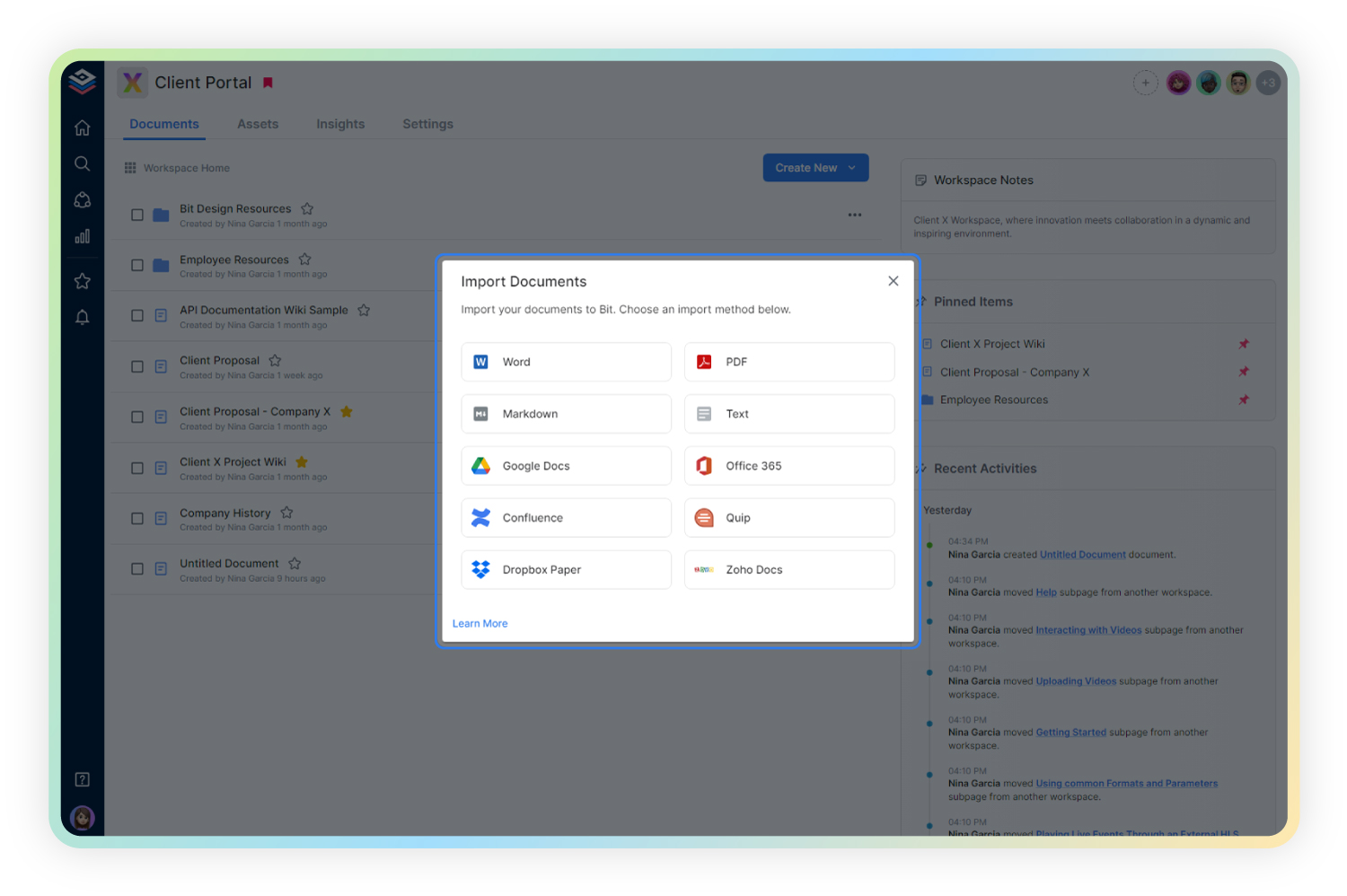 Want an easy way to include visual elements in your informational document? Then Bit is the perfect tool for you, because it supports multiple file formats and lets you seamlessly add videos, maps, charts, tables and so much more onto your document within a few seconds! Its smart integration allows you to add rich media elements like weblinks, pdfs, embeds, math equations, graphs, and make your informational report highly engaging!
Want an easy way to include visual elements in your informational document? Then Bit is the perfect tool for you, because it supports multiple file formats and lets you seamlessly add videos, maps, charts, tables and so much more onto your document within a few seconds! Its smart integration allows you to add rich media elements like weblinks, pdfs, embeds, math equations, graphs, and make your informational report highly engaging!
4. Multiple Workspaces
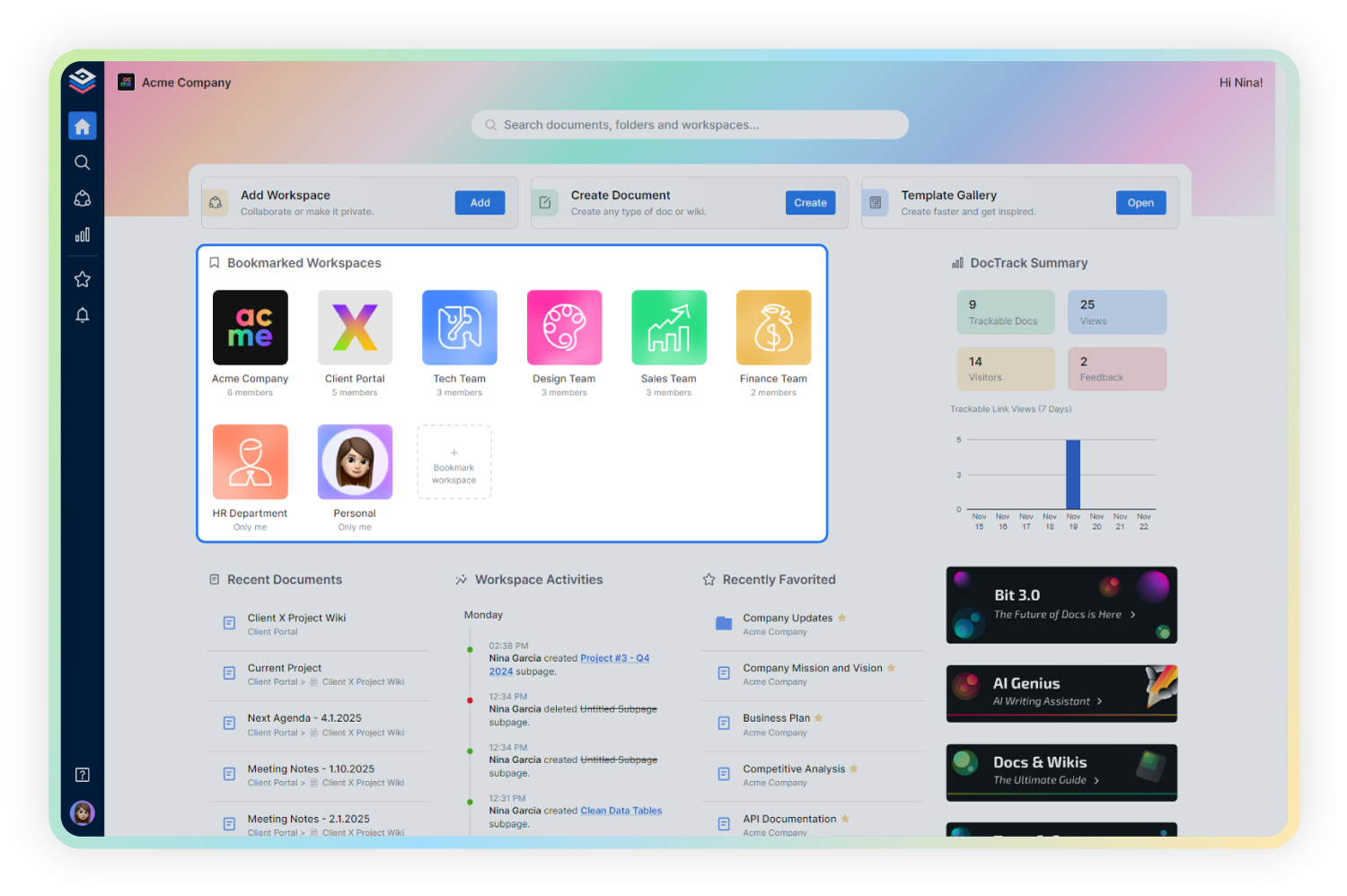 There is a lot of information and people involved in the creation of an informational document, and sometimes it can become chaos. But not with Bit around, because it lets you create infinite workspaces and folders around projects and teams to keep all your work organized. This lets you store all your information in a neat and orderly manner so that you can create informational reports much more efficiently.
There is a lot of information and people involved in the creation of an informational document, and sometimes it can become chaos. But not with Bit around, because it lets you create infinite workspaces and folders around projects and teams to keep all your work organized. This lets you store all your information in a neat and orderly manner so that you can create informational reports much more efficiently.
5. Real-time Collaboration
Bit’s has a real-time collaboration feature that allows you to invite people from multiple teams and departments to join you and work together in real-time to prepare information reports. You can edit, add comments, high to add collaborators who can proofread or edit your work.
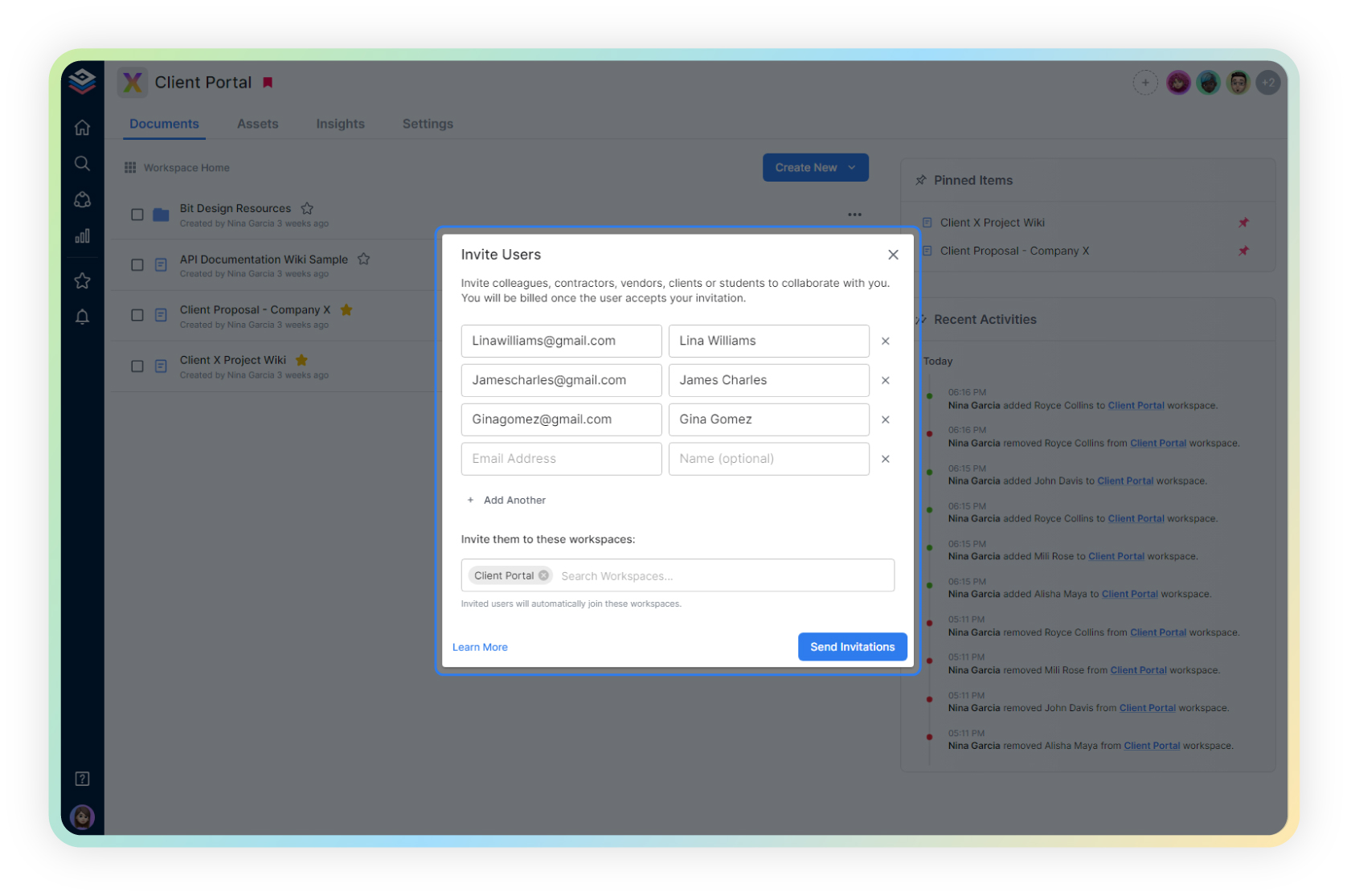 You have to admit, Bit is the whole package deal for writing reports! It will definitely change the way communicate and create information!
You have to admit, Bit is the whole package deal for writing reports! It will definitely change the way communicate and create information!
So what are you waiting around for? Get Bit and enjoy an easier and smoother life!
Conclusion
Information is all around us. Including this blog we just wrote for you. But gathering and writing it all down in an organized manner for a report is a whole other deal.
And we just helped you out with it! Not to mention our bonus recommendation of bit!
Now go out there and create your best informational reports!
Further Reads:
Master Project Reports Like a Pro (Even If You’re a Beginner!)
Report Writing Simplified: Follow This Proven Structure!
How to Write a Project Summary That Wins Approval Every Time
Fact Sheets That Wow: How to Create One in Minutes (Template Inside!)
